Light Rye Bread (no-knead, overnight recipe)
Light Rye Bread is a tasty, nutritious loaf that’s a great all-rounder. Whether you want it for sandwiches, toast, or to eat alongside soups and salad, the tangy flavour from rye, plus the goodness of wholemeal wheat flour and lightness from white bread flour, is a satisfying combination. And with my no-knead overnight method, it couldn’t be easier to get healthy Light Rye Bread.

Jump to Recipe
Apart from when I bake a simple white loaf (a bacon sandwich just has to be on white, doesn’t it?), it’s rare that my homemade breads contain just one type of flour. Adjusting the ratio of different flours (wholemeal, spelt, malthouse, rye, white, etc.) allows you to create a whole range of unique breads. Add to that the myriad nuts and seeds, plus flakes like rolled oats, and the possibilities are endless.

The lovely loaf I want to share with you today has three types of flour. As you might expect from my calling it Light Rye Bread, the most important of the three is rye flour. And that’s because of the subtle tang it brings to this versatile bread.
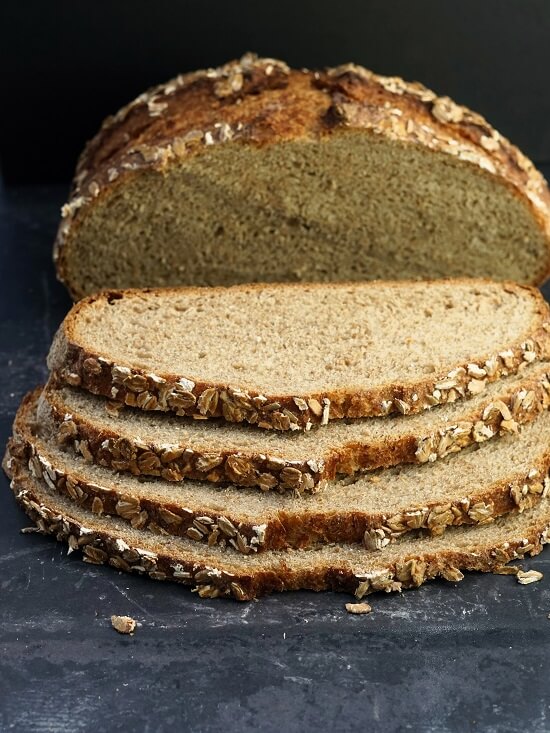
RYE BREAD
You may have heard that rye makes for heavier bread than wheat flour. It’s usually said that’s because it doesn’t have enough gluten-forming proteins. And it’s gluten that helps bread rise. However, some would argue that it does have good gluten content, just not the sort that’s much use for baking bread. But whatever the truth, almost all rye breads (pumpernickel being one exception) contain some wheat flour to lighten them. But how much?
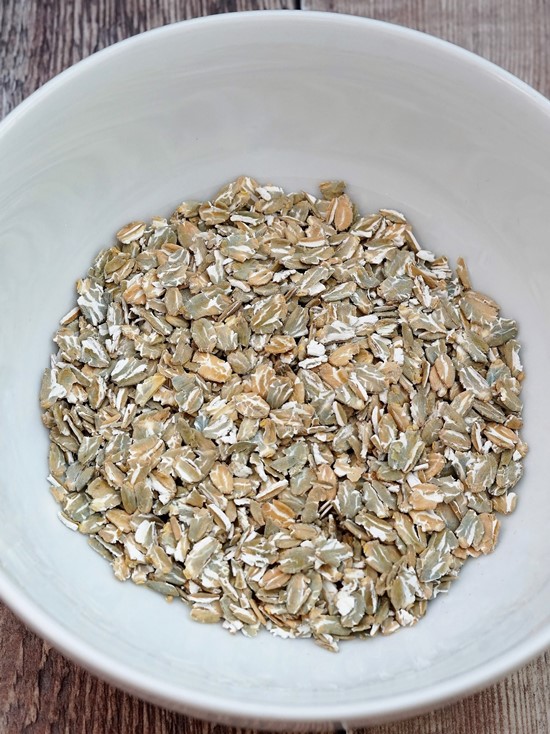
Over the last few months, I’ve been experimenting with different ratios of rye and wheat flour in my bread making. Although you can find some recipes which ‘cheat’ by adding colourings such as cocoa, coffee or even gravy browning (yes, really!), it’s the amount of rye in a loaf, relative to wheat, which determines whether a bread is a dark or light rye.
Dark rye breads will have more of the distinctive, tangy flavour that’s similar to sourdough bread. They’ll also be firmer, although a good one shouldn’t be unpleasantly heavy. I love dark rye breads matured for a few days. Then I cut it thinly and serve piled high with goodies in the style of Danish open sandwiches or smørrebrød.
At the other end of the scale, the tang of light rye breads should be more subtle. Their texture is softer too. I think these qualities make Light Rye Bread a great all-purpose, everyday bread. Wholesome, tasty, and versatile, you can use it to make regular sandwiches and toast, or eat it alongside salads, soups etc.
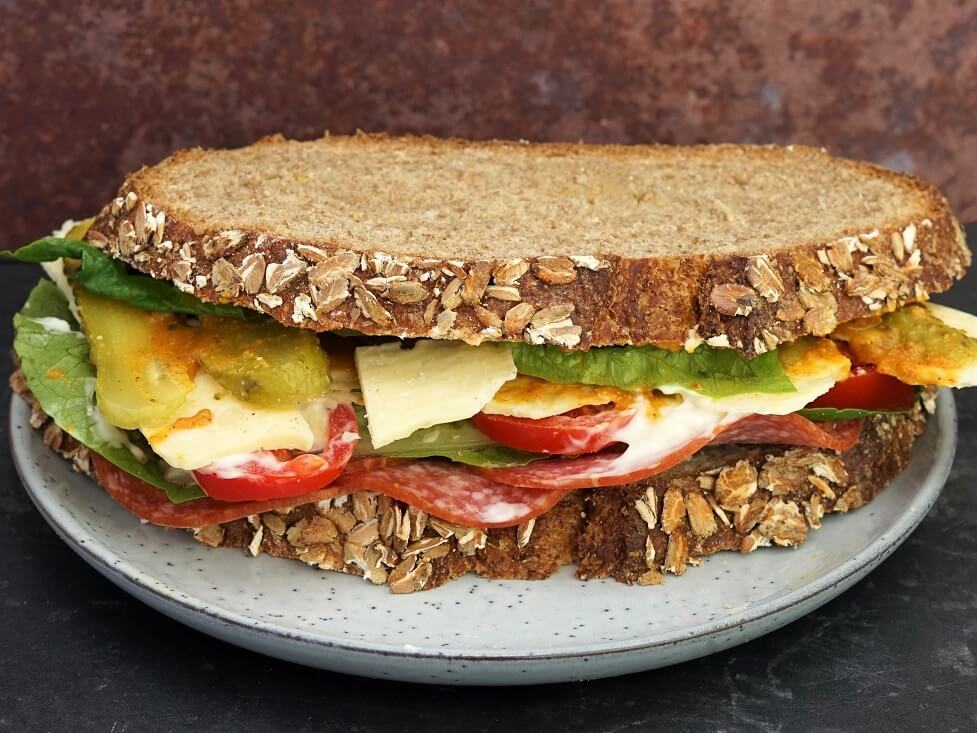
LIGHT RYE BREAD
While my own Dark Rye Bread contains 75 per cent stoneground wholemeal rye flour, for Light Rye Bread I reduce the rye content to a third. The remaining two thirds is made up of equal amounts of wholemeal and white bread flours. The recipe card at the end of the post makes one large loaf for which you’ll need 600 grams of flour in total. So that’s 200 grams of each. Because of rye’s relatively stronger taste I find that, even though it doesn’t make up the majority of the flour, it’s still noticeably a rye loaf.
If you’re new to rye bread, I highly recommend you follow my recipe as written and see how you like it. If you find you want more of a rye flavour then, next time, increase the amount of rye and reduce one (or a mixture) of the wholemeal or white flour by the same amount.

Besides the flours, the only other ingredients you’ll need are water, 2 teaspoons of salt, and 1.5 teaspoons of instant dried yeast. Note that for my method, you must only use dried yeast that is labelled ‘instant’, ‘fast‘, ‘easy blend‘ or similar. Check the pack to make sure it doesn’t need to be activated first rather than just adding straight to the flour.
I like a topping of rye flakes on my Light Rye Bread, but if you can’t get them, I explain later how you can make a traditional glaze instead.
NO KNEAD, OVERNIGHT BREAD
For virtually all my homemade bread, I use a no-knead method. In conventional bread making, we promote development of gluten by kneading. However, we can omit this if we create a wetter than usual dough and give it a long first rise, proof, or fermentation. When I say long, I mean roughly 12 – 14 hours. For most people, that’s going to be most convenient overnight. You can also slow down the first rise by putting the dough in the fridge for up to 24 hours. Just let it come back to room temperature before proceeding with the recipe.
As with many of my no-knead breads, my method for Light Rye Bread includes baking in a heavy, lidded cast iron pot or Dutch oven. The wettish dough produces lots of steam in the fiercely hot pot. This moist environment means the bread can keep rising for longer because the formation of a crust is delayed.

Because we bake the bread at a very high temperature, you’ll need a lidded pot that can be heated up to 240°C / 220° Fan / Gas 9 / 475° F. Don’t forget that any handles or knobs must be able to withstand that temperature too. Although they’re expensive, I think Le Creuset Signature casserole dishes are a great investment. They last for years and can be heated up to the required temperature. Of course, you may be able to find cheaper ones, or a Dutch oven, with similar properties that will work too.
For my round Light Rye Bread, I use my 24 cm casserole. This has a capacity of 4.2 litres. But going down to a minimum of 3.5 litres should be fine. If I want to make an oval loaf, then I use my 25 cm or 29 cm oval casserole.
HOW TO MAKE LIGHT RYE BREAD
You’ll find a detailed recipe card at the end of the post and you can Jump to Recipe now if you like. But I recommend you read the rest of the blog post first, especially if you’re new to my no-knead, overnight technique.

THE NIGHT BEFORE BAKING: MIX THE DOUGH
Because the first rise is going to take 12 – 14 hours, I get started in the early evening and bake the next morning. But your dough will come to no harm if you leave it an hour or two longer. As already mentioned, you can also extend the rising by doing it in the fridge for 24 hours.
To make the dough, all you do is stir together the flours, the salt, the instant dried yeast and water from the cold tap. Because different flours absorb different amounts of water, it isn’t possible to tell you the exact quantity you’ll need to create a wettish, but not sloppy, firm dough. I recommend starting with 350 ml, stir that in and add more as necessary. As a rough guide, for the Light Rye Bread shown in this post, I added a total of 430 ml. I use a sturdy silicone spatula to bring everything together, ensuring there are no dry bits of flour.
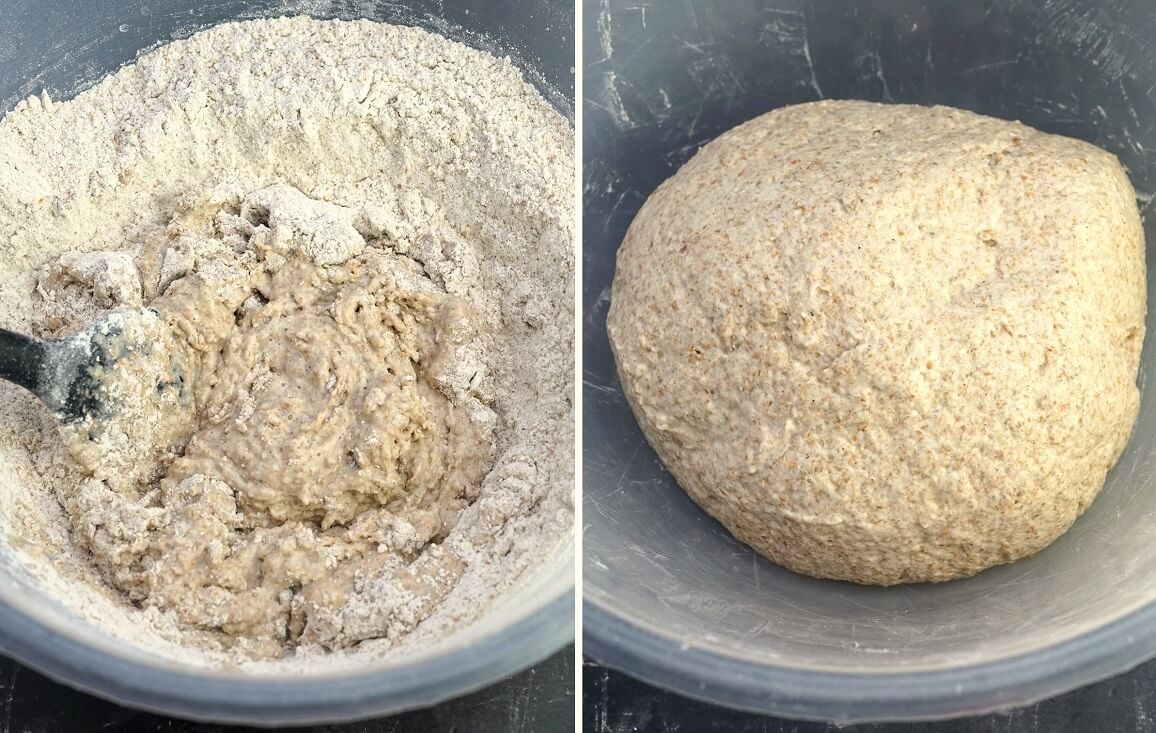
Now you can cover the bowl with cling film, a reusable polythene bag, or wet towel and set aside until the next day. Normal, unheated room temperature (here in the UK, outside of a heatwave, anyway) is usually fine. But if it’s a hot night or you live in a warmer climate then you can put the bowl in the fridge as per the longer fermentation.
THE NEXT DAY: SHAPING & SECOND PROOF
In the morning, don’t be surprised if the dough seems to have spread outwards more than it’s risen up. This is perfectly normal for wetter, no-knead doughs.
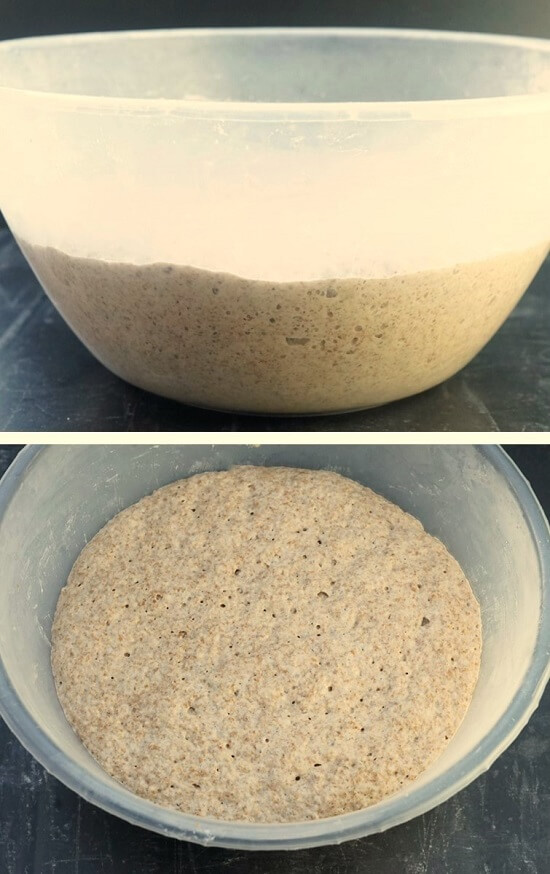
When you scrape it out onto a lightly floured work surface, you should see a complex network of gluten strands. Give the dough a few brief folds and turns, shaping it into a ball as you go, and you’ll quickly have a smooth dough.
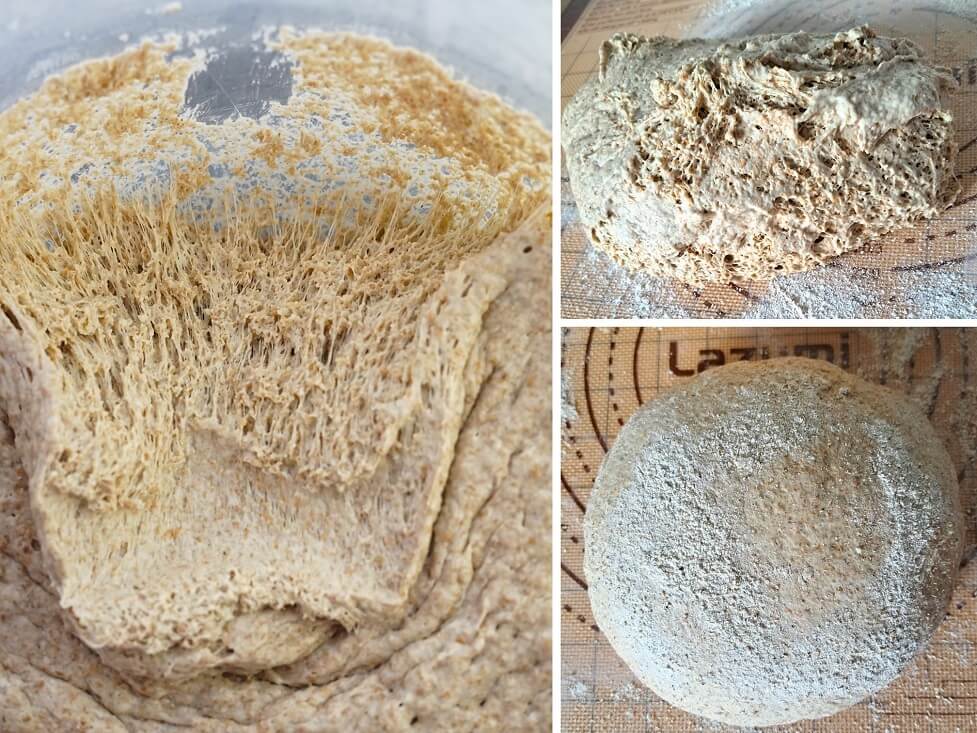
To support the dough on its second rise or proof, we put it into a floured container. I use special cane proving baskets called bannetons. They often come with a liner, but I think they’re unnecessary so long as the basket is well-floured. You can also make your own proofing vessel by lining a bowl with a clean tea towel and flouring the towel well.
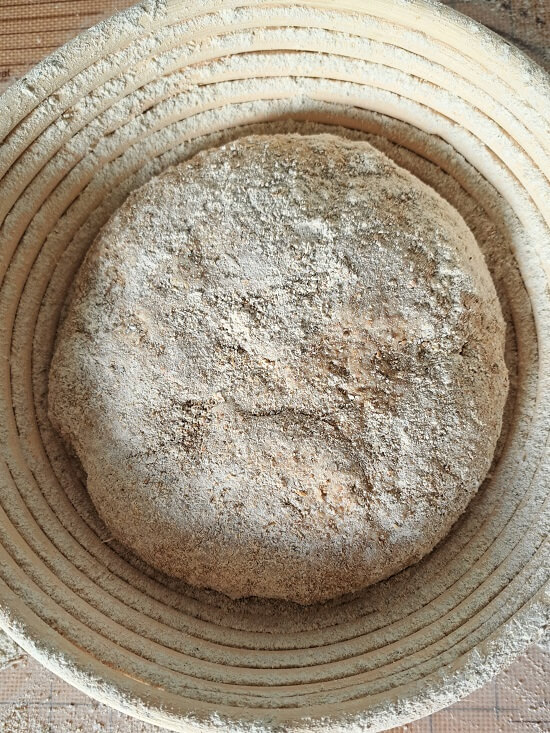
Put the ball of dough into the banneton or bowl so that the domed top is facing downwards. Now cover and leave it, ideally in a warmer spot this time. Unless it’s a hot day, I proof the dough in my small, unheated top oven while the one below is preheating. Depending on the temperature, this stage should take 30 – 45 minutes. The best was to check if the dough is ready is to gently insert a finger. Does it quickly or slowly spring back? If it springs back slowly and an impression is left by your finger, then the dough is ready. If the dough springs back immediately and doesn’t leave an impression, prove for longer then check again.
BAKING LIGHT RYE BREAD
While the dough’s proofing, put the cooking pot and its lid into the oven while it’s preheating. To get the pot as hot as possible, I set my oven to its highest temperature. When the dough’s ready, remove the pot from the oven and take off the lid. Now carefully flip the dough from its proving basket or bowl into the pot so that the rounded side that was underneath is now on top.
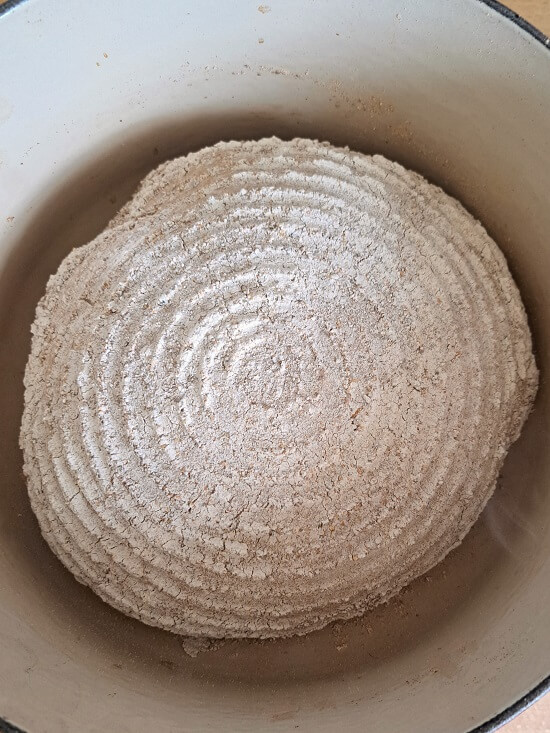
ADDING THE TOPPING OR GLAZE
Working quickly, so the pot stays hot, you can now add the topping or a glaze. I always have rye flakes in the cupboard, mainly as I include them in my Homemade Muesli. But I also add some to my Dark Rye Bread dough and scatter some on top of my Light Rye Bread. The best way to get them to stick is to first brush over a little egg white beaten with a splash of water. Then slash the dough and sprinkle the flakes over, trying not to let any fall into the slash. To make doubly sure they stay on, I gently press them down then brush on another layer of egg white.
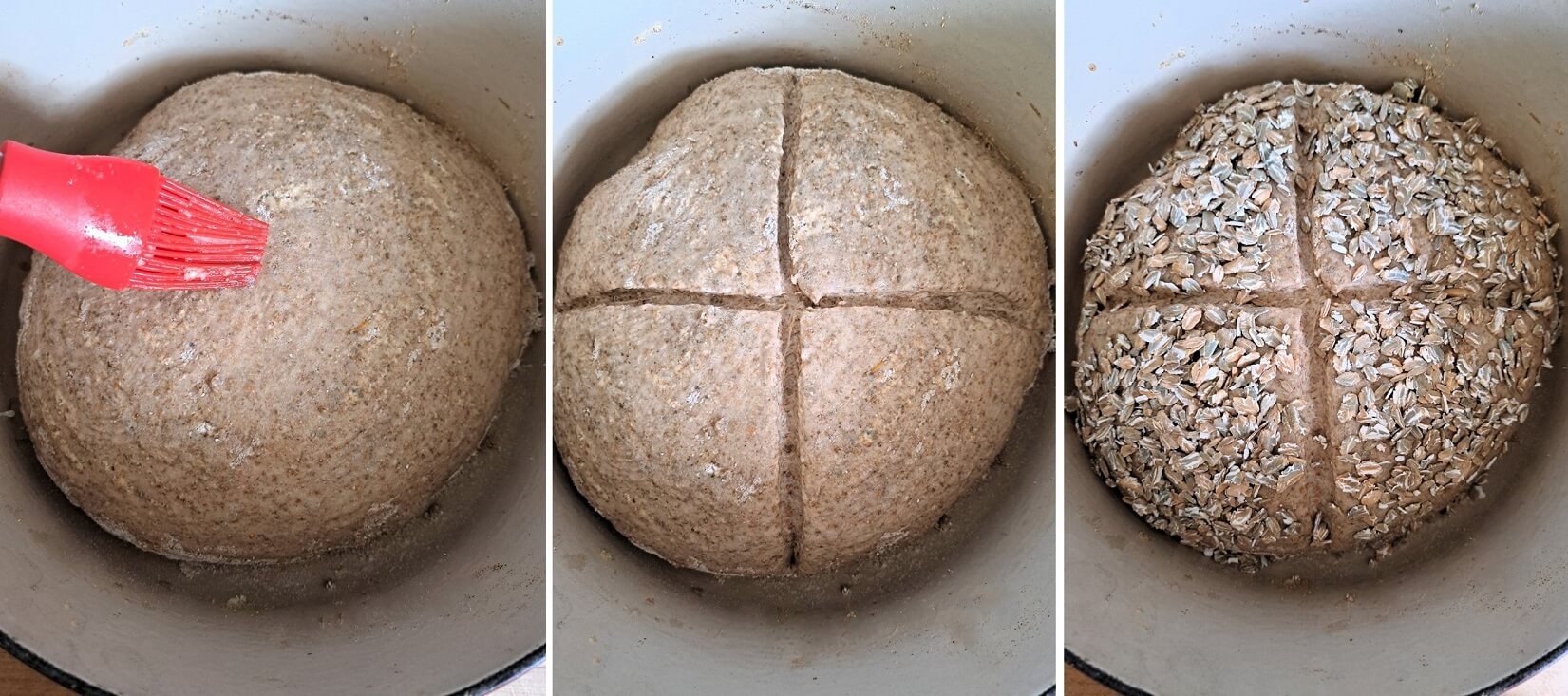
If you don’t have rye flakes then you could give the dough the lightly shiny, polished glaze that some traditional rye breads have. I’ve included how to do this in the Recipe Notes at the end. You heat up a small amount of rye flour and water, whisking until it thickens. Just before using, thin it with a little cold water. I put on two layers of this paste: immediately before it goes in the oven and after 30 minutes baking.
FIRST STAGE IN THE POT, SECOND STAGE OUT OF THE POT
You now quickly put the lid on the pot and place it in the oven. As soon as it’s in, turn the heat down to 240°C / 220° Fan / Gas 9 / 475° F and bake for 30 minutes. After 30 minutes, take the partially cooked loaf out of its pot. It should already be well risen and starting to brown nicely. If you’ve added the glaze rather than the rye flake topping, brush over the second layer now.
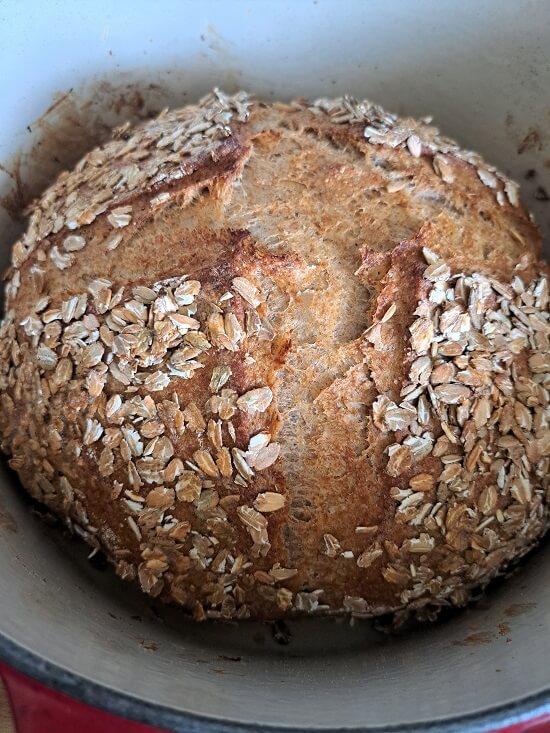
To ensure the loaf finishes cooking all the way through without over-browning, we turn the oven temperature down to 220°C / 200° Fan / Gas 7 / 425° F and put the bread back in directly on the shelf. It should be done in another 15 minutes or so, but check by tapping the bottom. If it sounds hollow then it should be ready. However, if in doubt, you can always switch the oven off and leave the bread in for another 3 – 5 minutes. Better to have it a little darker than undercooked and doughy.
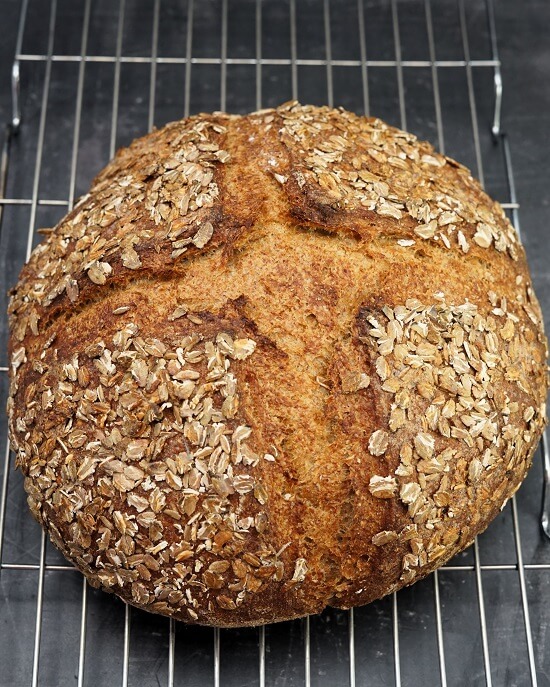
Put the finished loaf on a wire rack and leave until completely cold. I always prefer to leave my wholemeal breads until the next day before cutting into, but it can be eaten the same day if you really can’t wait. Light Rye Bread stays fresh for up to 4 days, but makes excellent toast after. It also freezes well: I slice before freezing so I can take out just as many slices as I need without waste.
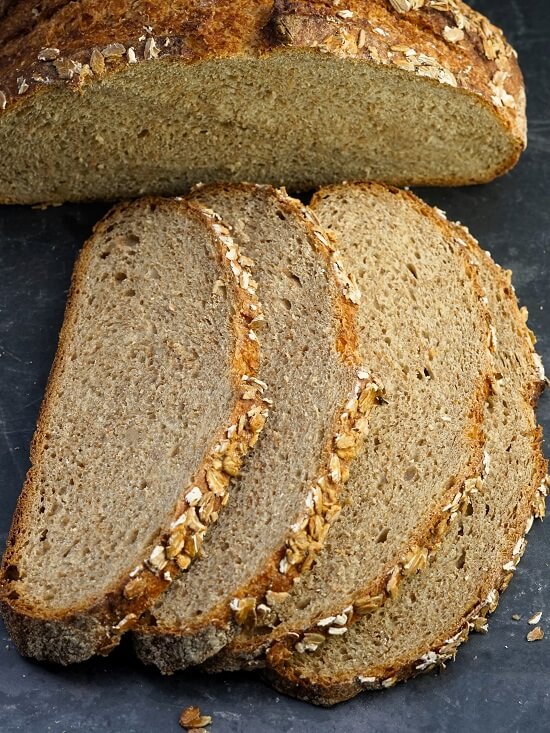
EASY, HOMEMADE LIGHT RYE BREAD
If you’re new to making rye bread, I think my Light Rye Bread is a great introduction. It’s a flavoursome loaf with a hint of the distinctive sourness loved by many. A healthy, fibre-filled bread that’s perfect for everyday use.
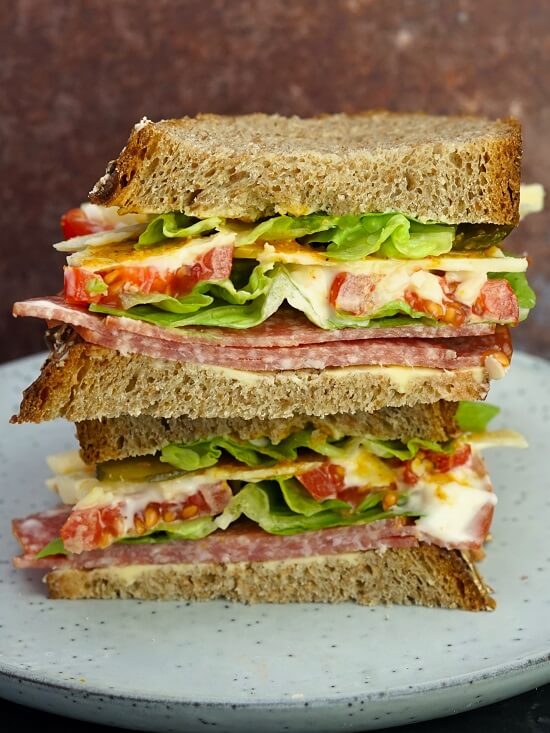
And with my no-knead, overnight method it couldn’t be easier. If you want more rye flavour, then my recipe can easily be adjusted. Keep the total weight of flour the same, just swap in more rye flour and take out an equal amount of wholemeal or white. But fancy going all the way to the dark side? Then try my Dark Rye Bread recipe.
IF YOU’VE MADE MY LIGHT RYE BREAD, I’D LOVE YOU TO LEAVE A COMMENT & RATING
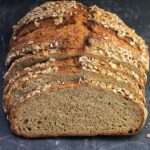
Light Rye Bread (no-knead, overnight recipe)
A tasty, nutritious loaf with a subtle tang of rye, plus the goodness of wholemeal wheat flour and lightness from white bread flour. A healthy everyday bread for sandwiches, toast, or to eat alongside soups and salad.
For more rye flavour, just replace some of the wholemeal or white wheat flour with wholemeal rye. Or try my Dark Rye Bread.
Ingredients
- 200 g wholemeal rye flour plus extra for dusting
- 200 g wholemeal bread flour
- 200 g white bread flour
- 2 tsp salt
- 1.5 tsp instant dried yeast i.e. the kind that does not require activating before use
- 400 - 450 g/ml water
For the topping (see Recipe Notes for alternative if you don't have rye flakes)
- 1 egg white beaten with a splash of water
- 2 tbsp rye flakes
Instructions
The night before you want to bake the bread
-
In a large mixing bowl, stir together all the flours, the salt and the instant dried yeast.
-
Pour approximately 350 g/ml of the cold water into the mixing bowl and use a sturdy silicone spoon or spatula to start bringing the ingredients together.
Add more water as needed to form a wet but not sloppy dough (see image in blog post for how it should look), stirring well so there are no dry bits of flour.
-
Cover the dough and leave overnight or 12 - 14 hours.
Tip: If the room is warm, or if you'd like a longer rise for convenience or to allow more flavour to develop, you can put the dough in the fridge for up to 24 hours. Bring the dough back up to room temperature before proceeding with the recipe.
On the day of baking
-
The dough should have risen, spread out, and be very bubbly. If not, leave a little longer.
-
Lightly flour a work surface and scrape the dough onto it.
Fold the dough over itself several times until it comes together into a smooth, round ball. Add more flour if needed, but only just enough to prevent sticking to the work surface.
-
Generously flour a round proving basket: if you don't have one then line a bowl with a clean tea towel and dust well with flour.
Transfer the ball of dough to the basket or tea towel lined bowl, placing it so the rounded top is now underneath.
Cover and leave to prove in a warm place for approximately 30 - 45 minutes.
-
While it's proving, preheat your oven to its highest setting and put on the middle shelf a cast iron pot or Dutch oven with its lid on.
-
Check if the dough is ready to bake: gently insert a finger into the dough and see if the dough quickly or slowly springs back.
- If the dough springs back slowly, leaving an impression, then it's ready.
- If it springs back immediately and doesn't leave an impression then leave to prove for longer and check again.
-
When ready to bake, remove the pot from the oven and take off the lid.
Carefully flip the dough from its proving basket or bowl into the pot so that the rounded side that was underneath is now on top.
Add the rye flake topping (work quickly so the pot stays hot)
- Brush a layer of beaten egg white over the top of the dough.
- Use a sharp knife, razor blade or baker's lame to cut a cross or a single slash across the top of the dough.
- Sprinkle over the rye flakes then very gently press down to help them stick: try not to let any fall into the slash.
- Brush over another layer of egg white.
SEE RECIPE NOTES FOR ADDING A GLAZE INSTEAD OF RYE FLAKES
-
Put the lid on the pot and place in the oven.
Immediately turn the heat down to 240°C / 220° Fan / Gas 9 / 475° F.
Bake for 30 minutes without removing the lid.
-
After 30 minutes, reduce the heat to 220° C / 200° Fan / Gas 7 / 425°F.
Remove the pot from the oven, tip the bread out of it, then return the loaf to sit directly on the oven shelf.
Bake for a further 15 minutes or until the bread is cooked through: it should sound hollow when tapped underneath.
-
Place on a wire rack until completely cold before slicing.
Best eaten within 3-4 days or can be frozen.
Tip: slice before freezing so you can take out just as much as you need without wastage.
Recipe Notes
Instead of topping with rye flakes, you can brush over a paste of rye flour and water to give a lightly glazed finish:
- Over moderate heat, whisk together 5 grams of rye flour and 25 grams/ml of water. Keep whisking until it boils and thickens. Take off the heat and leave to cool. Whisk in enough cold water to get a consistency like single cream.
- When you've flipped the proved dough into the hot pot, brush on a layer of the paste, slash the dough then put on the lid and transfer to the oven.
- As per the recipe, bake the bread for 30 minutes then turn out of the pot. Brush over another layer of the paste then put back in the oven and continue with the recipe.

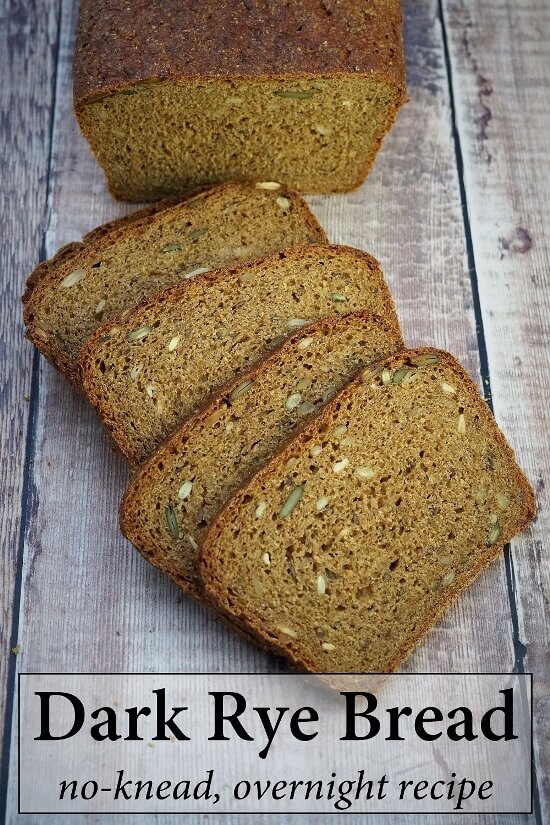
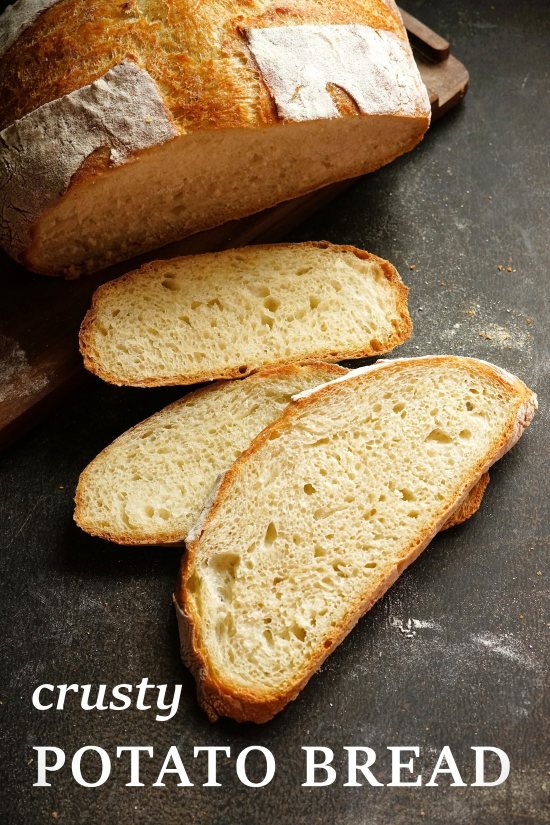
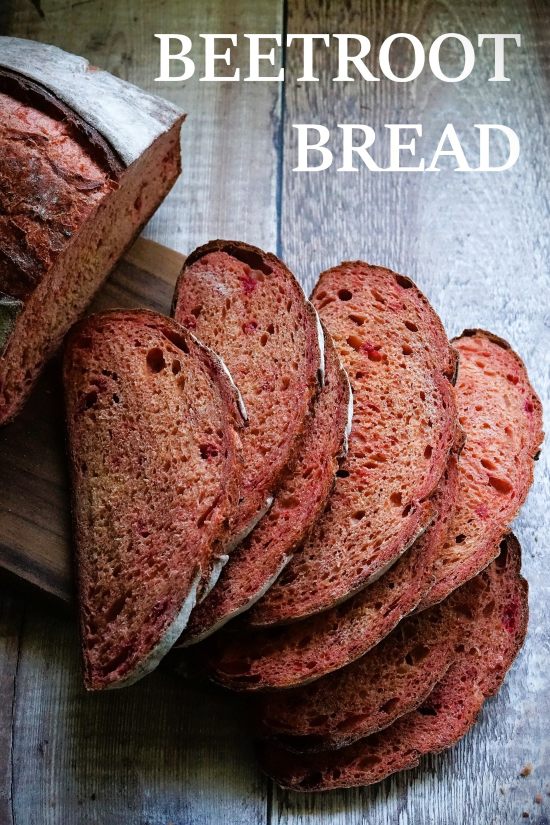
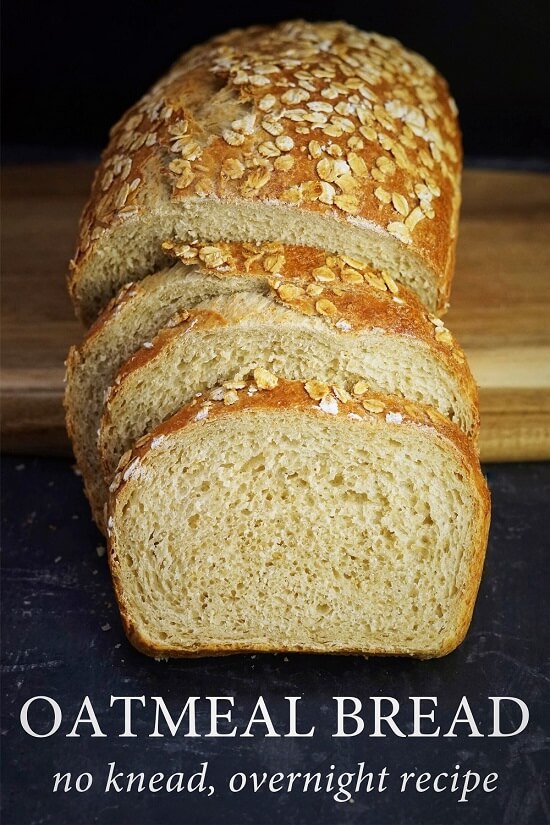
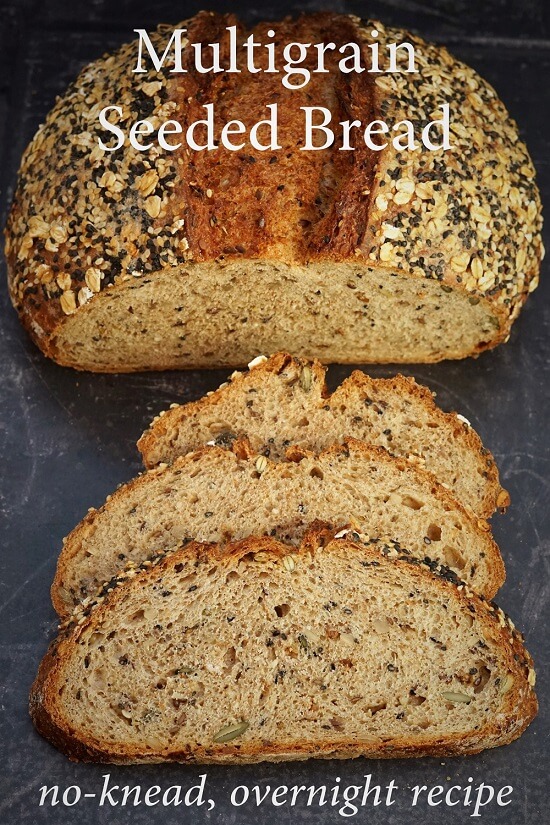

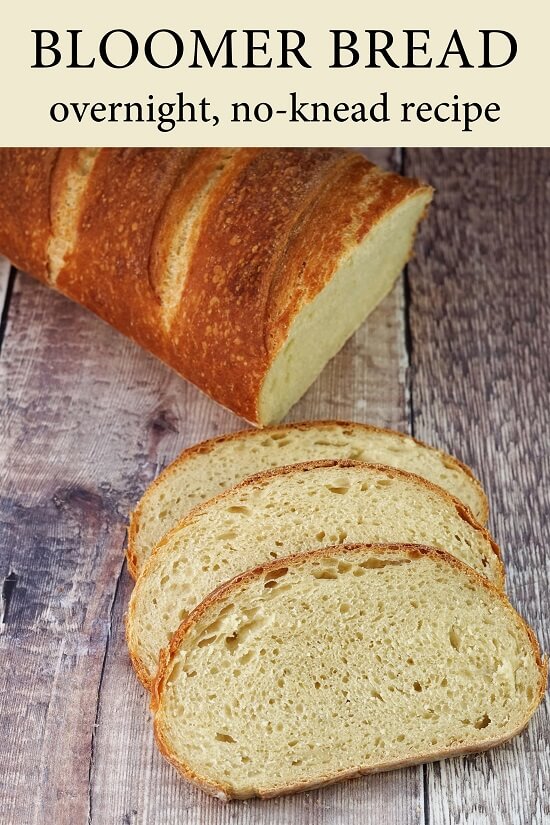
I have the other flours, but only have regular whole wheat flour. Will this recipe still work?
Hi Monica, if you mean that you don’t have whole wheat / wholemeal bread flour then I’m afraid the result won’t be the same. That’s because, due to the lower gluten content of the regular flour, you will not get the same rise. As rye flour has a similar effect, put them together and I think the loaf would be unpleasantly heavy.
My first attempt at the recipe, but have made numerous no-kneads in the past. I subbed spelt for whole meal. Flavour was good. I had to bake on a tray as my banneton is battard shaped and would not fit any lidded pots. Trouble was it turned out very flat like a foccacia. Every stage looked like the photos, except the finished product. Will keeping trying.
I’m afraid the reason your loaf was very flat is almost certainly due to the two important changes you made to the recipe: replacing the wholemeal flour with spelt and cooking on a tray instead of a very hot lidded pot.
Spelt has much less gluten potential and so doughs tend to spread out without the support of a tin or, in this case, a heavy pot. Likewise, because this overnight, no-knead dough is wetter than usual, it isn’t suitable for baking without support.
In addition, the moist environment created by the wet dough in the lidded pot means the bread can keep rising for longer because the formation of a crust is delayed.
I’m sorry your experience wasn’t great but, taken together, I’d say the changes you made were so different to my original recipe that it really isn’t the same thing at all.
If you wanted to try again baking on a tray, you should reduce the water and not include spelt.
Hope this helps.
This recipe produces lovely tasty bread with the minimum of fuss. More taste than ‘quicker’ recipes but without the complex workflow of sourdough. I can’t wait to get up in a morning to smell the yeasty goodness!
I’m afraid I’ve also abused the flour mix types to clear up old packets of various flours. And the result has always been reliable.
As a regular, but not expert, baker of bread this is now my ‘go to’ recipe. Maximum applause from the family for the minimum of work and fuss! Perfect
Thank you for your great feedback, John! So pleased you and the family enjoy this bread. And I heartily approve of mixing things up with whatever flours you want! Once you have the base recipe, the possibilities are endless.